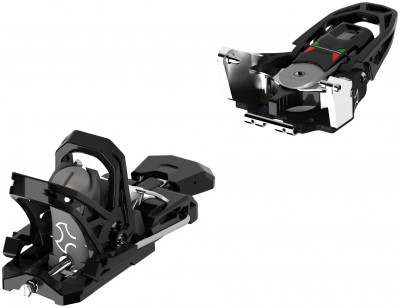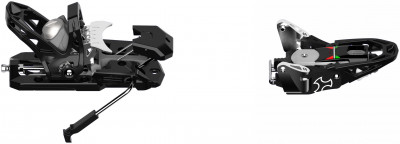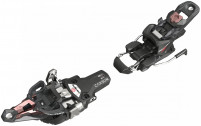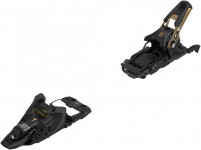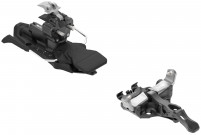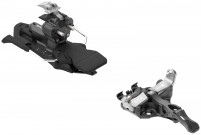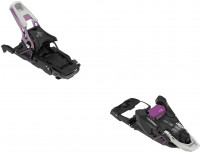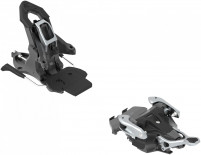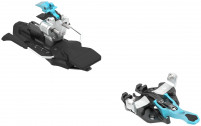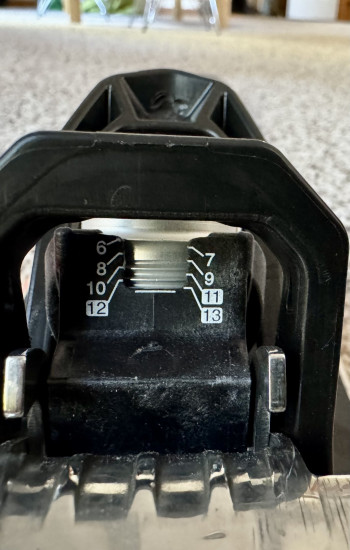Ski Trab TR1 Binding
The Ski Trab TR1 is the epitome of innovation coming from Ski Trab, and that is saying quite a lot for the company with a one-of-a-kind 14-layer ski construction and an utterly unique titanium-based elastic toepiece. Yet here we are, describing another paradigm-shifting product from our ingenious friends in Bormio, Italy. The prodigal son of the TR2, the TR1 (not the TR3, that would be a preposterous name) is designed to offer the same feature set while being compatible with a much wider selection of boots. No longer do you need a specific La Sportiva boot with specific heel inserts to enjoy Ski Trab's most technologically advanced binding to date.
Unlike many bindings in the touring world, the TR1 features a lateral toe release similar to an alpine binding, helping mitigate injuries to the tibia. The toepiece is built with lateral elasticity - whereby the toe wings move synchronously for better retention – as well as an incremental clamping force that allows you to tour with the toe lever unlocked, which provides greater safety when traveling through avalanche terrain. If you find yourself skiing in a "no fall zone," the toe can still be locked out for sections where losing a ski would be catastrophic.
While the toepiece is indisputably brilliant, the heel shines just as much. Whereas the TR2 used a pair of teeth that gripped special inserts on the boot, the TR1 has opted for a full steel shelf that presses the heel lug of the boot down against the binding, exactly like an alpine binding heel. Fore/aft elastic travel on the heel track keeps the release consistent and provides force feedback to your boot as the ski flexes through a turn. Because the boot is fully clamped down against the low-profile brake, the TR1 efficiently and instantaneously transfers energy from the boot to your edges, helping you power the ski through rough terrain. Finally, the two riser levels are easy to engage and the heel can be disengaged from the boot allowing you to switch back to touring mode without exiting the toepiece. If you want a binding that is built as hard as you ski, then you’ve met your match in the Ski Trab TR1.
- Vertical release at the heel and lateral release at the toe are adjustable between 6-13.
- Primary materials are aerospace-grade Ergal aluminum and steel with minimal plastic for extreme durability.
- Incremental clamping force in the toe wings allows secure touring with the toe unlocked for avalanche safety.
- Lateral elasticity in the toe and fore/aft in the heel makes the release characteristics more predictable and provides more feedback from the ski.
- Low-profile design keeps your boot closer to the ski for better control and responsiveness.
- 21mm of BSL adjustment lets you share this Italian marvel with your friends, or not!
| Specifications | |
|
Weight |
692g [102mm] |
| Weight (pair) | 1384g [102mm] |
|
Boot |
ISO 9523 & 23223 boots, ask for others |
|
Brakes |
88, 102, 112, 120 |
|
BSL |
21mm |
|
Riser |
2 |
|
Vertical |
6-13 |
|
Lateral |
6-13 |
|
Crampon |
Included Option |
| Specs Verified | Yes |
| Design | |
|
|
Ergal, hardened steel |
| Skimo Co Says | |
| Usage | Touring, free touring, resort crossover |
| Notes | Lateral release at the toe |
| Bottom Line | High-performance binding with a focus on safety |
| Compare to other Full-featured Bindings | |
Related Products
Questions & Reviews
The 102mm brake will fit a 106mm waist ski!
Thanks,
Steve
For a Voile BC ski use, you could argue they are heavier than needed for rolling terrain, but some folks love that combo with the releaseable heel to save transition time.
The heel lug depth is 6mm, spec says 7mm. Other then that, the height and radius match up well. So not ideal. We have contacted Ski Trab for an updated compatibility list.
We can confirm that it's the top-most flange, which is bigger than the rest of the threads on the screw. It's slightly hard to tell from that angle, but it looks to us like your binding in that photo would be set to 6, rather than 9.
What would be your recommendation?
Of the bindings you listed, the Shift2 is the only one that currently holds a TUV certification for release! Therefore, it gets an objective point in this regard. That's not to say that the other bindings aren't safe - just that they do not hold a certification for their reliability.
Of the hybrid-style bindings (pin toe and alpine heel), we would recommend the TR1! We have been impressed with its release consistency in our own testing, and it is built well, durable, and can certainly handle aggressive skiing. Feel free to email us if you'd like to dive in deeper - help@skimo.co!
The HY Free is new to the market and is not currently certified, but we would expect it to be among the best as well! It would be more comparable to the Shift in that it has a true alpine toe piece.
In terms of pure practicality for the kind of skiing you'll be doing, I think the TR1 would make sense as it is pretty light and tours and transitions more easily than a binding with an alpine toe piece!
I do t need anything this beefy now but in a couple years I’m hoping to be trying to keep up with my kids and might do something silly where this binding could be worth the weight.
It is a different hole pattern than the Titan Vario.2, unfortunately - you would need to get your skis re-mounted in order to switch to these.
It has a lot to do with the height and depth of the heel lug, which is a combination of the thickness of the outsole and the plastic of the shell itself. Specifically, the height of the heel lug should be 32mm +/- 2mm. ISO 9523 and Gripwalk boots work, as well as a handful of other lightweight boots. The Skorpius and Hawx should be good to go!
Compared to the Tecton, you should see very similar downhill performance as far as the on-ski feel. Both have pins at the front, lateral elasticity at the toe, and alpine-style heels with forward pressure. However, the TR1 does use more metal in the construction than the Tecton, and may offer more durability for skiing hard in and out of the resort.
Will TR1 be capable of atomic blackland and la sportiva spitfire 2.1?
The heels have a somewhat unique operation! When transitioning from walk to ski mode, you do have to "cock" the heel back by pushing it down so that it's ready to engage. At that point, it will begin to function like an alpine step-in heel clamp. You can go in and out of the binding in ski mode and the heel will remain step-in ready. When you go back to walk mode, you start the process over again.
It is relatively simple (once you learn how it works) to fully transition the heel from walk, to ski, and back to walk, without stepping out of the toe piece, which is cool!
Thanks.
The TR1 has adjustment built in at the heel to accommodate different boot sole lengths. There is no adjustable mounting plate to put under the toe piece so moving the mount point for a given boot will require re-mounting.
I tried to research more information about this binding but there is not much available. Therefore, I was wondering, since Skitrab is providing this binding with larger brakes in 112 and 120 mm is there a suitable binding to ski weight ratio for this binding? I mean, ATK usually recommends for the Raider 13 EVO a ski weight of max 1800 grams and for the Freeraider 15 EVO up to 2000 grams.
If I place the TR1 binding on a heavier ski like the Salomon QST 106 or Salomon Blank (both of them in the longest lengths) do you think it will be too much for this binding?
Also I have asked Skitrab about the boot compatibility with this binding and if the binding is suitable with a burlier hybrid touring boot such as the Scarpa Quatro Pro or other with a mix of Gripwalk and Touring sole and they said yes.
I just purchased this binding but I am still undecided if to used it or not on a heavier ski or not.
I looked through the Ski Trab catalog, and they do not list a maximum weight for skis to pair with this binding. One of my coworkers put his pair of TR1s on a 2000+ gram, 108mm resort ski and has been loving the combination. It has a strong alpine-style clamp at the heel and is built very tough, so I feel confident that this binding can handle any ski you'd like to throw at it.
I think I saw a ramp angle or 2.6 degrees but just wondering what that translates to in mm.
Thanks
Earn store credit by writing reviews. Learn more.






